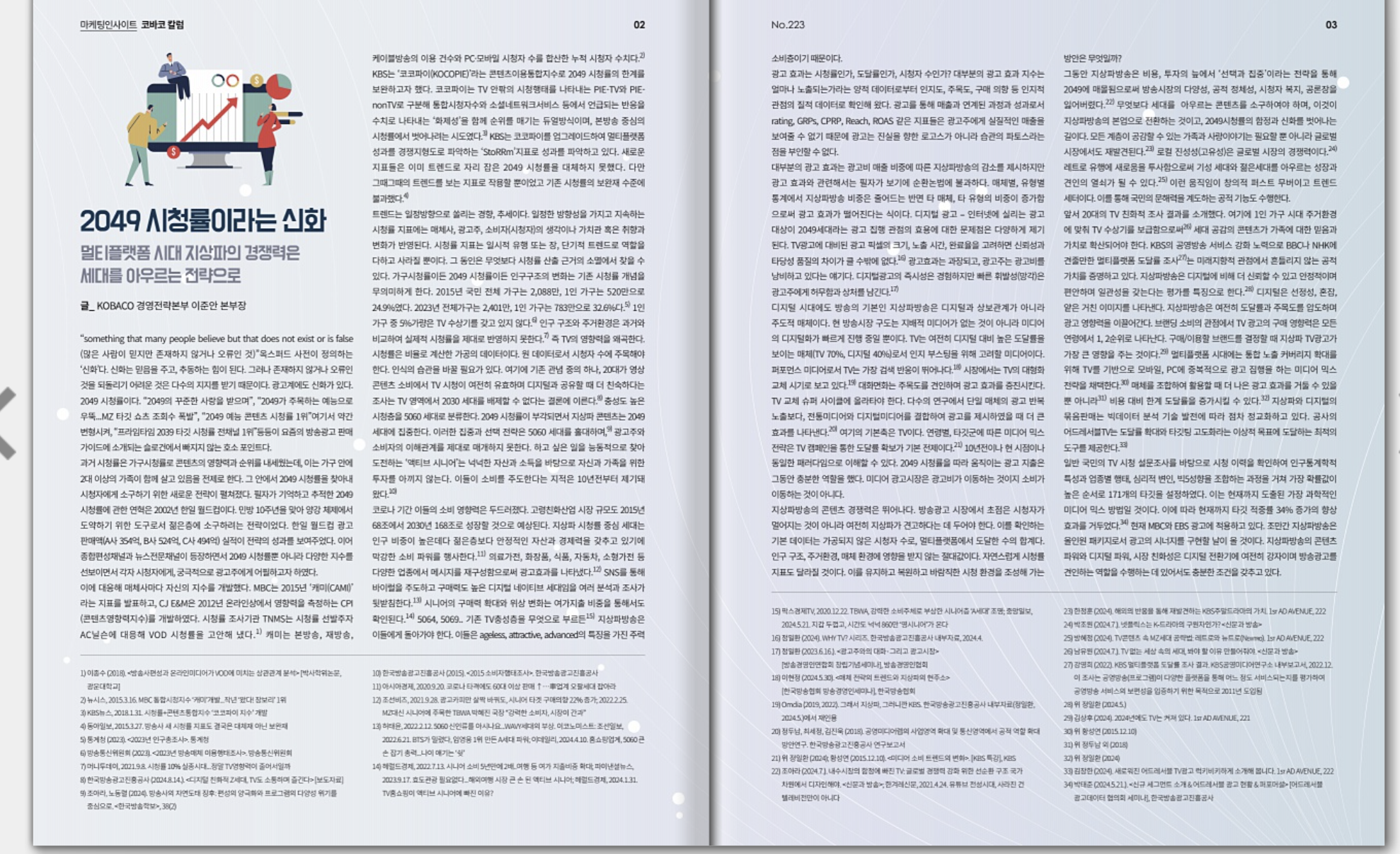멀티 플랫폼 시대, 지상파 경쟁력은 5060 품는 국민 TV전략 (In the era of multi-platform, TV station is a national TV strategy that embraces 5060)
이준안 코바코 경영전략본부장 "2049에 집중하는 TV들이 주시청층이나 소비층 5060을 홀대하고 있다"고 주장. "모든 세대를 아우르는 콘텐츠와 광고 전략이 미래의 성공을 좌우할 것:
이준안 코바코 경영전략본부장 칼럼(2024년 9월 광고일번지)
http://aii.co.kr/hosting/company/e-book/ecatalog5.php?Dir=74

한국의 TV광고 트렌드 분석, 광고 동향, 청약 가격 등이 포함된 전문지 ‘광고 일번지’에 실린 이준안 경영전략본부장의 기고 글입니다.
이 본부장은 글에서 "광고업계에서 흔히 신화처럼 여겨지는 '2049 시청률'에 대한 비판을 중심으로, 현재의 광고 전략과 시청률 지표 문제점을 데이터와 함께 심도 있게 지적"하며 "시청률 분절 시대, 지상파 TV는 5060세대에 더 집중하는 국민 TV전략을 써야 한다"고 강조했습니다.
글 핵심 요약
2049 시청률의 신화
- 2049 시청률은 광고주들이 중시하는 20세에서 49세 사이의 시청자를 겨냥한 지표로, 이 연령대가 가장 중요한 소비층으로 여겨져 왔음
- 그러나 이 지표가 실제로는 모든 시청층을 충분히 반영하지 못하며, 특히 점점 증가하는 1인 가구나 고령층의 시청 습관을 무시하고 있다는 점 지적
변화하는 인구 구조
- 2015년 대비 2023년 1인 가구 비율이 24.9%에서 32.6%로 증가하였고, 이들 중 5%는 TV를 아예 보유하고 있지 않다는 사실은 전통적인 시청률 지표가 현실을 반영하지 못하고 있음을 보여줌.
- 인구 구조의 변화는 기존의 시청률 개념을 무의미하게 만들며, 이러한 상황에서 '시청자 수'라는 절대적인 데이터에 더 집중할 필요가 있음.
시청률 지표의 한계와 대안
- 다양한 방송사와 광고 회사들이 시청률을 보완하기 위해 새로운 지표들을 개발해 왔지만, 2049 시청률을 대체하지 못하고 있음
- TV와 디지털 미디어의 결합을 통한 광고 효과가 더 크며, 단순히 시청률에 의존하는 대신 다양한 연령층을 포괄하는 전략이 필요
5060 세대의 중요성
- 50대 이상의 시니어 세대는 경제력이 높고, 소비 주도층으로 부상. 그러나 현재의 광고 전략은 이들을 소외시키고 있음
- 시니어 세대는 디지털에도 익숙한 '액티브 시니어'로, 이들을 포함한 포괄적인 콘텐츠 전략이 필요.
미래 방향
- 지상파 방송은 디지털 시대에도 여전히 높은 신뢰성과 도달률을 자랑하며, TV 광고는 여전히 모든 연령대에서 중요한 영향을 미침
- 앞으로는 TV를 중심으로 한 통합적인 미디어 믹스 전략이 더욱 중요해질 것이며, 다양한 세대가 공감할 수 있는 콘텐츠 개발이 필요
글의 결론
광고계는 2049 시청률에 지나치게 의존하기보다, 변화하는 인구 구조와 시청자 수에 기반한 새로운 전략을 마련해야 함
모든 세대를 아우르는 콘텐츠와 광고 전략이 미래의 성공을 좌우할 것

This is an article by 이준안(Junan Lee), Head of Business Strategy at KOBACO, published in ‘1st AD AVENUE’ a specialized magazine that analyzes Korean TV ad trends, upcoming and featured TV programs
KOBACO(Korea Broadcast Advertising Corporation) is the only media representative in South Korea operating as an agency that represents major TV station and network of South Korea for their TV ad sales and ad promotion.
In the article, Lee "criticizes the 'only 2049 viewership', which is often considered a myth in the ad industry, and points out the problems of current ad strategies and viewership indicators in depth with data," emphasizing that "in the era of viewership fragmentation, TV station should use a national TV strategy that focuses more on the 5060 generation."
Key Summary
The Myth of 2049 Ratings
- The 2049 ratings target viewers aged 20 to 49, a demographic considered the most important consumer group by advertisers.
- However, this metric fails to adequately reflect all viewer demographics, particularly the growing single-person households and the aging population, which is increasingly being overlooked.
Changing Demographics
- Between 2015 and 2023, the proportion of single-person households increased from 24.9% to 32.6%, with 5% of these households not owning a TV at all. This indicates that traditional rating metrics are becoming less reflective of reality.
- Changes in population structure render the old concept of ratings obsolete, emphasizing the need to focus more on the absolute number of viewers.
Limitations of Rating Metrics and Alternatives
- Various broadcasters and advertising companies have developed new metrics to supplement traditional ratings, but none have successfully replaced the 2049 TV ratings.
- Combining TV with digital media in advertising has shown greater effectiveness, and the focus should shift from solely relying on ratings to embracing strategies that encompass all age groups.
The Importance of the gen5060
- The senior generation, aged 50 and above, possesses significant economic power and has emerged as a key consumer group. However, current advertising strategies tend to marginalize them.
- These "active seniors" are also digitally savvy, and strategies that include them are crucial for comprehensive content and advertising plans.
Future
- Despite the rise of digital media, major TV station still boasts high trust and reach, and TV advertising remains highly influential across all age groups.
- Moving forward, an integrated media mix strategy centered around TV will become increasingly important, and developing content that resonates with a broad range of generations will be key to future success.
Conclusion
The advertising industry should move away from over-reliance on demographic 2049 TV ratings and develop new strategies based on changing demographics and viewer numbers. Content and advertising strategies that include all generations will determine future success.
뉴스레터를 구독하세요.
지금 뉴스레터를 구독하세요.






![[프리미엄 리포트] 미국 케이블TV 2025, 변화와 미래 전략](https://storage.googleapis.com/cdn.media.bluedot.so/bluedot.directmedialab/2025/05/vj931j_202505270106.png)




